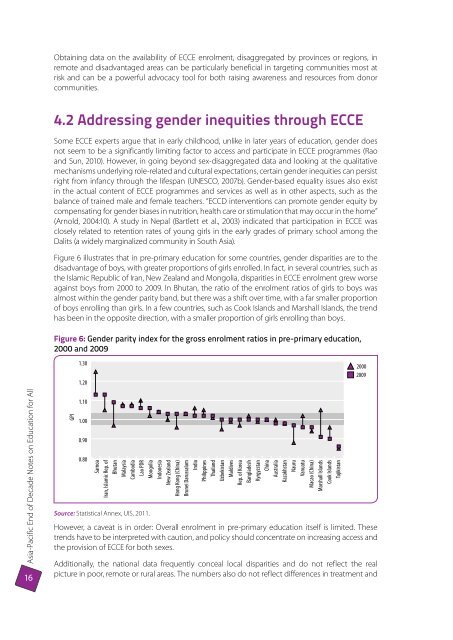EFA Goal 1: Early childhood care and education; Asia ... - Unicef
EFA Goal 1: Early childhood care and education; Asia ... - Unicef
EFA Goal 1: Early childhood care and education; Asia ... - Unicef
You also want an ePaper? Increase the reach of your titles
YUMPU automatically turns print PDFs into web optimized ePapers that Google loves.
Obtaining data on the availability of ECCE enrolment, disaggregated by provinces or regions, in<br />
remote <strong>and</strong> disadvantaged areas can be particularly beneficial in targeting communities most at<br />
risk <strong>and</strong> can be a powerful advocacy tool for both raising awareness <strong>and</strong> resources from donor<br />
communities.<br />
4.2 Addressing gender inequities through ECCE<br />
Some ECCE experts argue that in early <strong>childhood</strong>, unlike in later years of <strong>education</strong>, gender does<br />
not seem to be a significantly limiting factor to access <strong>and</strong> participate in ECCE programmes (Rao<br />
<strong>and</strong> Sun, 2010). However, in going beyond sex-disaggregated data <strong>and</strong> looking at the qualitative<br />
mechanisms underlying role-related <strong>and</strong> cultural expectations, certain gender inequities can persist<br />
right from infancy through the lifespan (UNESCO, 2007b). Gender-based equality issues also exist<br />
in the actual content of ECCE programmes <strong>and</strong> services as well as in other aspects, such as the<br />
balance of trained male <strong>and</strong> female teachers. “ECCD interventions can promote gender equity by<br />
compensating for gender biases in nutrition, health <strong>care</strong> or stimulation that may occur in the home”<br />
(Arnold, 2004:10). A study in Nepal (Bartlett et al., 2003) indicated that participation in ECCE was<br />
closely related to retention rates of young girls in the early grades of primary school among the<br />
Dalits (a widely marginalized community in South <strong>Asia</strong>).<br />
Figure 6 illustrates that in pre-primary <strong>education</strong> for some countries, gender disparities are to the<br />
disadvantage of boys, with greater proportions of girls enrolled. In fact, in several countries, such as<br />
the Islamic Republic of Iran, New Zeal<strong>and</strong> <strong>and</strong> Mongolia, disparities in ECCE enrolment grew worse<br />
against boys from 2000 to 2009. In Bhutan, the ratio of the enrolment ratios of girls to boys was<br />
almost within the gender parity b<strong>and</strong>, but there was a shift over time, with a far smaller proportion<br />
of boys enrolling than girls. In a few countries, such as Cook Isl<strong>and</strong>s <strong>and</strong> Marshall Isl<strong>and</strong>s, the trend<br />
has been in the opposite direction, with a smaller proportion of girls enrolling than boys.<br />
Figure 6: Gender parity index for the gross enrolment ratios in pre-primary <strong>education</strong>,<br />
2000 <strong>and</strong> 2009<br />
1.30<br />
1.20<br />
2000<br />
2009<br />
<strong>Asia</strong>-Pacific End of Decade Notes on Education for All<br />
16<br />
GPI<br />
1.10<br />
1.00<br />
0.90<br />
0.80<br />
Samoa<br />
Iran, Islamic Rep. of<br />
Bhutan<br />
Malaysia<br />
Cambodia<br />
Lao PDR<br />
Mongolia<br />
Indonesia<br />
New Zeal<strong>and</strong><br />
Hong Kong (China)<br />
Brunei Darussalam<br />
India<br />
Philippines<br />
Thail<strong>and</strong><br />
Uzbekistan<br />
Maldives<br />
Rep. of Korea<br />
Bangladesh<br />
Kyrgyzstan<br />
China<br />
Australia<br />
Kazakhstan<br />
Nauru<br />
Vanuatu<br />
Macao (China)<br />
Marshall Isl<strong>and</strong>s<br />
Cook Isl<strong>and</strong>s<br />
Tajikistan<br />
Source: Statistical Annex, UIS, 2011.<br />
However, a caveat is in order: Overall enrolment in pre-primary <strong>education</strong> itself is limited. These<br />
trends have to be interpreted with caution, <strong>and</strong> policy should concentrate on increasing access <strong>and</strong><br />
the provision of ECCE for both sexes.<br />
Additionally, the national data frequently conceal local disparities <strong>and</strong> do not reflect the real<br />
picture in poor, remote or rural areas. The numbers also do not reflect differences in treatment <strong>and</strong>

















